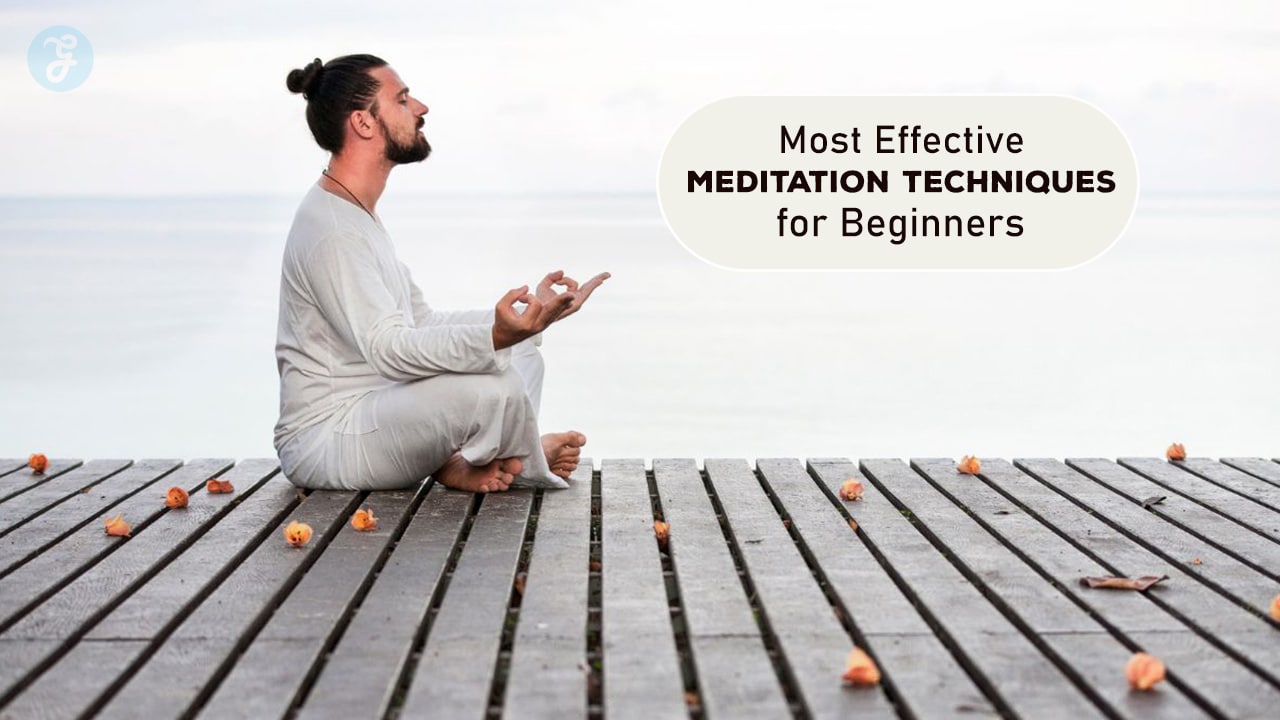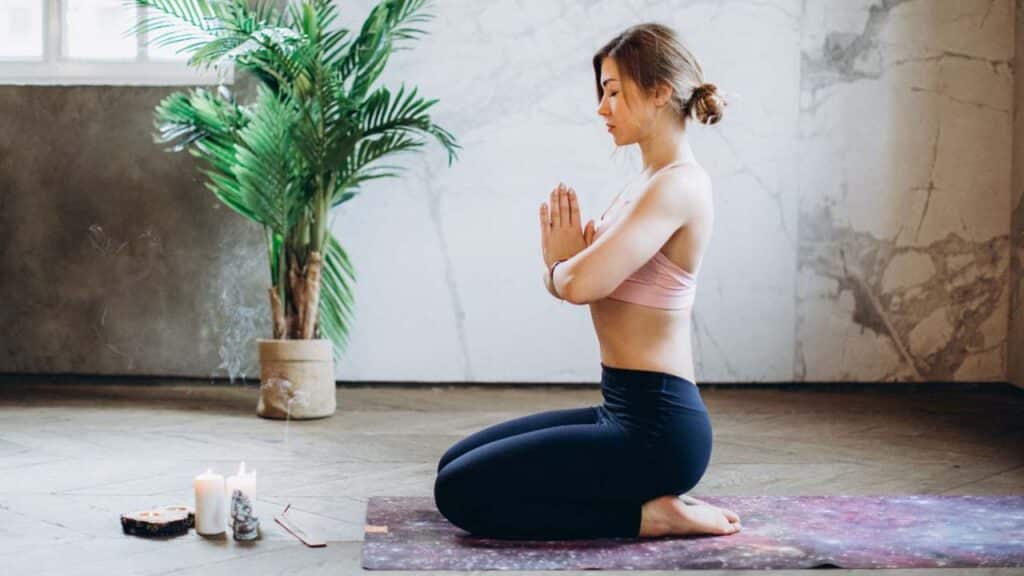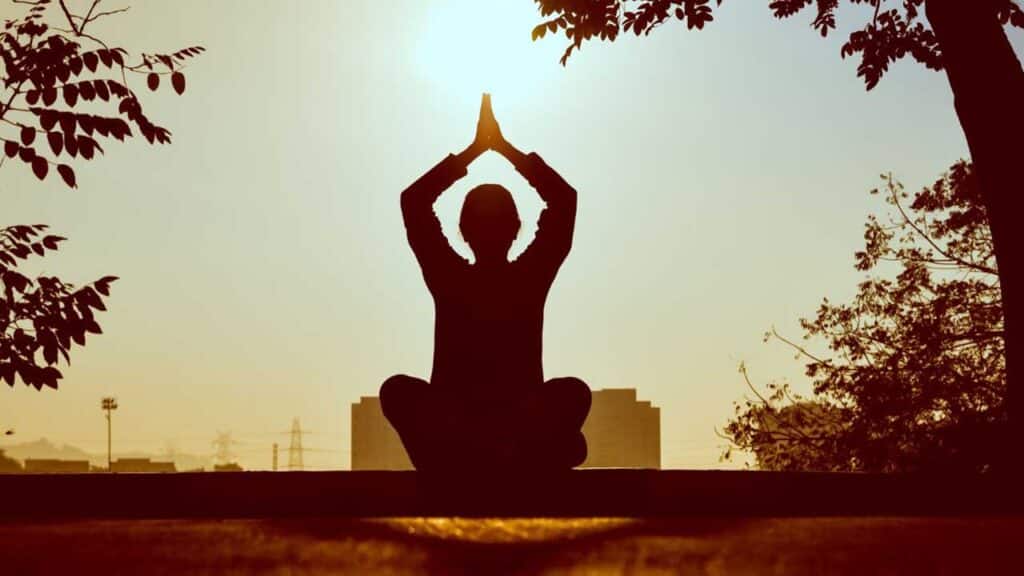Meditation has become an increasingly popular practice for those seeking peace, clarity, and balance in their busy lives. As a beginner, you might feel overwhelmed by the various meditation techniques, each offering unique benefits and approaches.
This guide introduces ten of the most effective meditation techniques for beginners, designed to help you find the proper practice that suits your needs and preferences.
Whether you want to reduce stress, improve focus, or enhance your overall well-being, these techniques provide a solid foundation to start your meditation journey.
1. Mindful Breathing (Anapanasati)
Mindful breathing, also known as Anapanasati in Buddhist traditions, is one of the most fundamental and accessible meditation techniques for beginners.
This practice focuses on using the breath as an anchor for attention, helping to calm the mind and bring awareness to the present moment.
How to Practice:
- Find a comfortable position on a cushion on the floor or in a chair with your feet flat on the ground.
- Close or soften your gaze, focusing on a spot a few feet before you.
- Take a few deep breaths to settle into your body and the present moment.
- Begin to observe your natural breathing pattern without trying to change it.
- Focus on the sensation of the breath entering and leaving your body. You might notice the air moving through your nostrils, your chest’s rise and fall, or your abdomen’s expansion and contraction.
- When your mind wanders (which is entirely typical), gently bring your attention back to your breath without judgment.
- Start with 5-10 minutes and gradually increase the duration as you become more comfortable with the practice.
Benefits:
- Reduces stress and anxiety
- Improves focus and concentration
- Enhances self-awareness
- Promotes emotional regulation
- It helps in managing physical pain
Tips for Beginners:
- Be patient with yourself. It’s normal for your mind to wander frequently at first.
- Try counting your breaths (1 to 10, then start over) to help maintain focus.
- Experiment with different points of focus (nostrils, chest, or abdomen) to see what feels most natural for you.
- Practice at the same time each day to establish a routine.
Mindful breathing is an excellent foundation for any meditation practice. Its simplicity makes it accessible to everyone, while its profound effects on the mind and body make it a technique you can return to throughout your meditation journey.
2. Body Scan Meditation
Body scan meditation is a powerful technique that systematically focuses your attention on different body parts. This practice helps develop a heightened awareness of bodily sensations, promotes relaxation, and can be particularly beneficial for those dealing with stress, anxiety, or physical discomfort.
How to Practice:
- Lie on your back comfortably or sit in a chair if lying down is uncomfortable.
- Close your eyes and take a few deep breaths to center yourself.
- Begin by focusing your attention on your toes. Notice any sensations like warmth, coolness, tingling, or pressure.
- Slowly move your attention up through your body, focusing on each part: feet, ankles, calves, knees, thighs, hips, lower back, abdomen, chest, upper back, fingers, hands, arms, shoulders, neck, and head.
- As you focus on each area, observe any sensations without judgment. If you don’t feel anything in a particular area, that’s okay too.
- If you notice tension or discomfort, try to breathe into those areas, imagining the breath softening and releasing the tension.
- Once you’ve scanned your entire body, take a moment to notice how your body feels as a whole.
- Slowly open your eyes and gently move your body, taking time to come back to full awareness.
Benefits:
- Promotes deep relaxation
- Increases body awareness
- It helps identify and release physical tension
- Can improve sleep quality
- Enhances mind-body connection
Tips for Beginners:
- Start with shorter sessions (10-15 minutes) and gradually increase the duration.
- If you are distracted, return your focus to the last body part you remember scanning.
- Try practicing at different times of the day to see when it’s most effective for you.
- Consider using a guided body scan meditation audio or app when starting.
Body scan meditation is an excellent technique for beginners as it provides a structured approach to meditation. Focusing on physical sensations can make staying present and engaged easier than more abstract forms of meditation.
This practice can benefit those who find it challenging to sit still or experience physical discomfort during meditation.
3. Loving-Kindness Meditation (Metta)
Loving-kindness meditation, also known as Metta meditation in the Buddhist tradition, is a practice that focuses on cultivating feelings of love, compassion, and goodwill towards yourself and others.
This technique is particularly effective for developing emotional resilience, improving relationships, and fostering a positive outlook.
How to Practice:
- Find a comfortable seated position and close your eyes.
- Take a few deep breaths to center yourself.
- Begin by directing loving-kindness towards yourself. Silently repeat phrases such as:
- “May I be happy”
- “May I be healthy”
- “May I be safe”
- “May I live with ease”
- As you repeat these phrases, try to generate feelings of warmth and compassion towards yourself.
- After a few minutes, extend these wishes to a loved one, repeating similar phrases:
- “May [name] be happy.”
- “May [name] be healthy.”
- “May [name] be safe.”
- “May [name] live with ease.”
- direct these wishes to a neutral person (someone you neither like nor dislike).
- if you feel ready, extend these wishes to a difficult person in your life.
- Finally, expand your loving-kindness to all beings everywhere.
- End the session by returning your focus to yourself and taking a few deep breaths.
Benefits:
- Increases feelings of connection and empathy
- Reduces negative emotions like anger and resentment
- Improves self-esteem and self-compassion
- Enhances overall emotional well-being
- It can help in managing symptoms of depression and anxiety
Tips for Beginners:
- Start with shorter sessions (5–10 minutes) and gradually increase the duration.
- If you struggle with self-compassion, direct loving-kindness to a loved one or a pet.
- Personalize the phrases to make them more meaningful to you.
- Don’t worry if you don’t feel strong emotions initially; the practice is about the intention.
Loving-kindness meditation is an excellent technique for beginners who want to cultivate positive emotions and improve their relationships with themselves and others. It’s particularly beneficial for those dealing with self-criticism, social anxiety, or feelings of isolation.
By regularly practicing loving-kindness meditation, you can develop a more compassionate and understanding perspective on yourself and the world around you.
4. Guided Visualization Meditation
Guided visualization meditation is a technique that involves creating vivid, positive mental images to promote relaxation, healing, and personal growth. This practice benefits beginners as it provides a structured experience and can be easier to follow than silent meditation.
How to Practice:
- Find a comfortable position, either sitting or lying down.
- Close your eyes and take a few deep breaths to relax.
- Listen to a guided visualization recording or have someone read a script to you.
- Follow the instructions, using your imagination to create detailed mental images.
- Engage all your senses in the visualization – sight, sound, smell, taste, and touch.
- Stay present with the imagery and gently redirect your attention if your mind wanders.
- At the end of the visualization, take a few moments to return to your surroundings slowly.
Benefits:
- Reduces stress and anxiety
- Enhances creativity and problem-solving skills
- Improves sleep quality
- Boosts motivation and goal-setting
- Can aid in pain management and healing processes
Tips for Beginners:
- Start with shorter guided visualizations (5-10 minutes) and gradually increase the duration.
- Choose visualizations that resonate with your personal goals or interests.
- If you struggle to visualize, focus on the feelings and sensations associated with the imagery.
- Practice regularly to improve your visualization skills over time.
Guided visualization meditation is an excellent choice for beginners who find it challenging to sit in silence or have active imaginations. It can be particularly beneficial for those dealing with stress, anxiety or those seeking to manifest specific goals in their lives.
By regularly engaging in guided visualization, you can harness the power of your mind to create positive changes in your thoughts, emotions, and even your physical well-being.
5. Mantra Meditation
Mantra meditation is a technique that involves the repetition of a word, phrase, or sound to focus the mind and achieve a state of deep concentration. This practice has roots in various spiritual traditions, including Hinduism and Buddhism, but can also be adapted for secular use.
How to Practice:
- Choose a mantra that resonates with you. This could be a traditional Sanskrit mantra like “Om” or “So Hum,” a positive affirmation in your language, or even a simple sound.
- Find a comfortable seated position and close your eyes.
- Take a few deep breaths to center yourself.
- Begin repeating your chosen mantra silently in your mind or softly out loud.
- Focus your attention on the sound and vibration of the mantra as you repeat it.
- If your mind wanders, gently bring your attention back to the mantra without judgment.
- Continue for your desired duration, starting with 5-10 minutes and gradually increasing as you become more comfortable with the practice.
Benefits:
- Improves concentration and focus
- Reduces mental chatter and overthinking
- Promotes a sense of calm and inner peace
- It can help in managing stress and anxiety
- Deepens spiritual connection (if that’s your intention)
Tips for Beginners:
- Experiment with different mantras to find one that feels right for you.
- Try synchronizing the mantra with your breath for added focus.
- Don’t worry about perfect pronunciation; the intention behind the practice is more important.
- Use mala beads (a string of 108 beads) to help keep track of your repetitions, if desired.
Mantra meditation can benefit beginners who find it challenging to quiet their minds. The repetition of a mantra provides a focal point for attention, making it easier to let go of distracting thoughts.
This technique can be especially beneficial for those drawn to meditation’s rhythmic or auditory aspects.
Now that we’ve covered five meditation techniques, let me know if you’d like me to continue with the remaining five techniques or if you have any questions or feedback on what I’ve written so far.
6. Walking Meditation
Walking meditation is a mindfulness practice that involves bringing your attention to the physical sensations of walking. This technique is excellent for beginners who find it challenging to sit still for extended periods or those who want to integrate meditation into their daily activities.
How to Practice:
- Choose a quiet path or area to walk back and forth for about 10-15 steps.
- Stand at one end of your path, feet hip-width apart, and take a few deep breaths.
- Begin walking slowly and deliberately, paying close attention to the sensations in your feet and legs as you move.
- Notice the lifting, moving, and placing of each foot.
- When you reach the end of your path, pause, take a breath, and turn around mindfully.
- Continue walking back and forth, focusing on the physical sensations of walking.
- If your mind wanders, gently bring your attention to the walking process.
- Start with 5-10 minutes and gradually increase the duration as you become more comfortable.
Benefits:
- Improves balance and physical awareness
- Enhances concentration and focus
- It provides a gentle form of exercise
- It can be practiced almost anywhere
- Helps integrate mindfulness into daily activities
Tips for Beginners:
- Walk slower than usual to heighten your awareness of each movement.
- Try coordinating your breath with your steps for added focus.
- Practice both indoors and outdoors to experience different sensations.
- Use gentle labels in your mind, such as “lifting,” “moving,” and “placing,” to help maintain focus.
Walking meditation mainly benefits those who find traditional seated meditation challenging or want to bring mindfulness into their daily activities. It’s an excellent way to practice mindfulness while getting light exercise, making it a versatile and accessible technique for beginners.
7. Zen Meditation (Zazen)
Zen meditation, also known as Zazen, is a traditional Buddhist practice emphasizing simplicity and direct experience. While it can be challenging for beginners, its straightforward approach makes it an excellent foundation for developing a solid meditation practice.
How to Practice:
- Find a quiet space and sit on a cushion or chair with your back straight.
- If sitting on a cushion, cross your legs in a comfortable position. If in a chair, keep your feet flat on the ground.
- Rest your hands in your lap, palms up, with your dominant hand on top. Your thumbs should be touching, forming an oval shape.
- Keep your eyes half-open, with your gaze resting on the ground about 3-4 feet in front of you.
- Take a few deep breaths to settle into the position.
- Focus on your breath, particularly the sensation of breathing in your lower abdomen.
- Allow thoughts to come and go without engaging with them. Think of them as clouds passing in the sky.
- If you get caught up in thoughts, gently return your focus to your breath.
- Start with 5-10 minutes and gradually increase the duration as you become more comfortable.
Benefits:
- Develops intense concentration and focus
- Promotes a sense of calm and clarity
- Enhances self-awareness and insight
- Reduces stress and anxiety
- Can lead to deeper spiritual understanding (if that’s your goal)
Tips for Beginners:
- Start with shorter sessions and gradually build up to longer ones.
- Use a timer to avoid checking the clock during practice.
- Be patient with yourself; it’s normal for the mind to wander frequently at first.
- Consider joining a Zen meditation group or retreat for guidance and support.
Zen meditation’s simplicity can be both its strength and its challenge. While it might seem daunting initially, many beginners find that this direct approach helps them develop a strong foundation in meditation practice.
The emphasis on posture and breath awareness can lead to profound insights and a deep sense of presence.
8. Transcendental Meditation (TM)
Transcendental Meditation is a specific form of mantra meditation popularized in the West by Maharishi Mahesh Yogi. While the official TM technique requires instruction from a certified teacher, we can explore a simplified version that captures the essence of the practice.
How to Practice:
- Find a comfortable seated position with your back straight.
- Close your eyes and take a few deep breaths to relax.
- Silently repeat a simple, meaningless sound (like “om” or “hum”) in your mind.
- Allow the mantra to repeat itself naturally without forcing it.
- If other thoughts arise, gently return your attention to the mantra without judgment.
- Continue for 15-20 minutes, twice daily.
- When the time is up, sit quietly for a few minutes before opening your eyes.
Benefits:
- Reduces stress and anxiety
- Improves focus and clarity of thought
- Enhances creativity and problem-solving skills
- Promotes emotional well-being
- It can lower blood pressure and reduce the risk of heart disease
Tips for Beginners:
- Choose a time and place where you won’t be disturbed for your practice.
- Be consistent with your practice, aiming for twice daily sess-twice-daily worry about whether you’re doing it “right” – the key is approaching the practice quickly and without strain.
- If you want to learn the official TM technique, consider seeking a certified instructor.
While this simplified version captures the essence of Transcendental Meditation, it’s worth noting that the official TM technique involves personalized instruction and a specific mantra given by a certified teacher.
However, even this simplified approach can offer significant benefits, especially for beginners looking to reduce stress and improve overall well-being.
9. Chakra Meditation
Chakra meditation is a practice rooted in yogic traditions that focuses on balancing the body’s energy centers, known as chakras. This technique can be particularly beneficial for those interested in exploring the mind-body connection and working with subtle energies.
How to Practice:
- Sit comfortably with your spine straight and close your eyes.
- Take a few deep breaths to center yourself.
- Begin at the base of your spine, focusing on the root chakra. Visualize a red spinning wheel of energy.
- As you inhale, imagine drawing energy from the earth into this chakra. As you exhale, visualize the chakra glowing brighter and spinning freely.
- Move up to the sacral chakra (below the navel), visualizing an orange energy wheel. Repeat the process of breathing and visualization.
- Continue moving up through each chakra:
- Solar Plexus Chakra (upper abdomen) – Yellow
- Heart Chakra (center of chest) – Green
- Throat Chakra (throat) – Blue
- Third Eye Chakra (between eyebrows) – Indigo
- Crown Chakra (top of head) – Violet
- Spend a minute or two on each chakra or longer if drawn to a particular energy center.
- After reaching the crown chakra, take a moment to visualize all chakras aligned and spinning harmoniously.
- Slowly open your eyes and take a few deep breaths to ground yourself.
Benefits:
- Promotes balance in physical, emotional, and spiritual aspects of life
- Enhances self-awareness and intuition
- It can help identify and release emotional blockages
- Improves overall energy flow in the body
- Deepens the mind-body connection
Tips for Beginners:
- Start with shorter sessions, focusing on one or two chakras at a time.
- Use guided chakra meditations to help you visualize and work with each energy center.
- Don’t worry if you can’t “see” the colors vividly; focus on the intention and any sensations you experience.
- Consider learning more about the qualities associated with each chakra to deepen your practice.
Chakra meditation can be an engaging and insightful practice for beginners, especially those drawn to energy work or seeking to explore the connection between their physical and emotional states. While it may seem complex at first, with regular practice, many find it a powerful tool for self-discovery and healing.
10. Mindful Observation Meditation
Mindful observation meditation is a simple yet profound practice focusing on a single object or your immediate environment. This technique is excellent for developing present-moment awareness and can be easily integrated into daily life.
How to Practice:
- Choose an object of focus. This could be a natural object like a flower, tree, or something in your immediate environment, like a cup or furniture.
- Find a comfortable sitting or standing position to observe your object without straining.
- Take a few deep breaths to center yourself.
- Begin to observe the object with full attention, as if you’re seeing it for the first time.
- Notice its colors, shapes, textures, and any patterns or details you might not have noticed before.
- If your mind starts to wander or you begin to label or analyze the object, gently bring your attention back to simply observing.
- Try to maintain this focused observation for 5–10 minutes.
- When you’re ready to end the practice, take a few deep breaths and slowly expand your awareness of your surroundings.
Benefits:
- Enhances present-moment awareness
- Improves concentration and focus
- Reduces overthinking and mental chatter
- Cultivates a sense of wonder and appreciation for everyday objects
- It can be practiced anywhere, at any time
Tips for Beginners:
- Start with objects that naturally interest you to make the practice more engaging.
- Try practicing with different types of objects to keep the experience fresh.
- If you find your mind wandering frequently, try shorter sessions of 2-3 minutes and gradually increase the duration.
- Use this technique throughout your day to bring mindfulness to routine activities.
Mindful observation meditation is an excellent technique for beginners as it provides a concrete focal point for attention. It can benefit those who struggle with more abstract forms of meditation or want to develop their ability to stay present in daily life.
Final thoughts
The ten meditation techniques explored here offer a diverse range of practices for beginners, each with unique benefits and approaches. Whether you prefer the simplicity of mindful breathing, the emotional warmth of loving-kindness meditation, or the structured guidance of visualizations and mantras, a technique can suit your needs.
These practices can help reduce stress, improve focus, enhance emotional well-being, and deepen your connection to yourself and the world around you.
By starting with these techniques and gradually exploring more, you can build a strong foundation for lifelong meditation, leading to greater peace, clarity, and overall well-being.















































